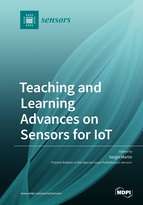Teaching and Learning Advances on Sensors for IoT
A special issue of Sensors (ISSN 1424-8220). This special issue belongs to the section "Internet of Things".
Deadline for manuscript submissions: closed (31 May 2020) | Viewed by 25822
Special Issue Editor
Interests: ad hoc networks; aquatic surface vehicles deployment; unmanned aerial vehicle fleet; path planning techniques; machine and deep learning; reinforcement learning
Special Issues, Collections and Topics in MDPI journals
Special Issue Information
Dear Colleagues,
The Internet of Things (IoT) is widely considered the next step towards a digital society where objects and people are interconnected and interact through communication networks. The IoT not only has a huge social impact, but can also support the employability and boost the competitiveness of companies. It is widely considered one of the most important key drivers for the implementation of the so-called Industry 4.0 and for the digital transformation of the companies.
Sensing is a fundamental part of IoT environments, where massive amounts of data are constantly sensed. Proper quality data acquisition leads to more accurate decision-making. Thus, the importance of good practices when sensing data in IoT environments is growing.
The rapid diffusion of IoT technologies has created an important educational challenge, namely the need to train a large number of professionals able to design and manage a fast evolving and complex ecosystem. Thus, an important research effort is being carried out in innovative technologies (simulators, virtual and remote labs, mobile apps, robotics, e-learning platforms, gamification, learning analytics, etc.) applied to innovative teaching practices.
This Special Issue focuses on all the technologies involved in improving the teaching and learning process of some of the sensor-based IoT topics such as virtual sensors, simulated data acquisition, virtual and remote labs for IoT sensing, gamification experiences and innovative teaching materials among others.
Dr. Sergio MartinGuest Editor
Manuscript Submission Information
Manuscripts should be submitted online at www.mdpi.com by registering and logging in to this website. Once you are registered, click here to go to the submission form. Manuscripts can be submitted until the deadline. All submissions that pass pre-check are peer-reviewed. Accepted papers will be published continuously in the journal (as soon as accepted) and will be listed together on the special issue website. Research articles, review articles as well as short communications are invited. For planned papers, a title and short abstract (about 100 words) can be sent to the Editorial Office for announcement on this website.
Submitted manuscripts should not have been published previously, nor be under consideration for publication elsewhere (except conference proceedings papers). All manuscripts are thoroughly refereed through a single-blind peer-review process. A guide for authors and other relevant information for submission of manuscripts is available on the Instructions for Authors page. Sensors is an international peer-reviewed open access semimonthly journal published by MDPI.
Please visit the Instructions for Authors page before submitting a manuscript. The Article Processing Charge (APC) for publication in this open access journal is 2600 CHF (Swiss Francs). Submitted papers should be well formatted and use good English. Authors may use MDPI's English editing service prior to publication or during author revisions.
Keywords
- Virtual sensors
- Virtual laboratories for IoT
- Remote laboratories for IoT
- IoT simulators
- IoT demonstrators
- Mobile apps for IoT learning
- Innovative teaching practices
- Gamification
- Learning analytics
- Open educational resources and repositories for IoT learning
- Platforms for IoT learning
- Big Data
- DIY/Maker experiences







